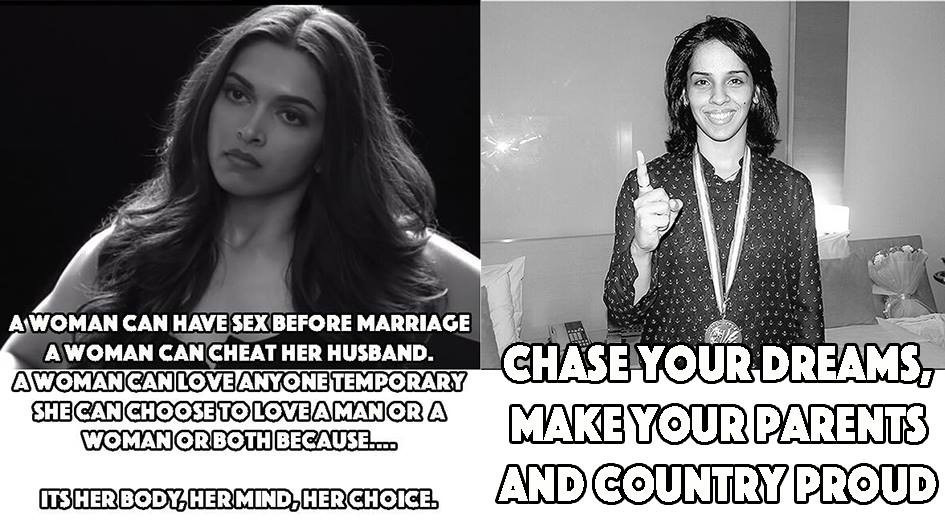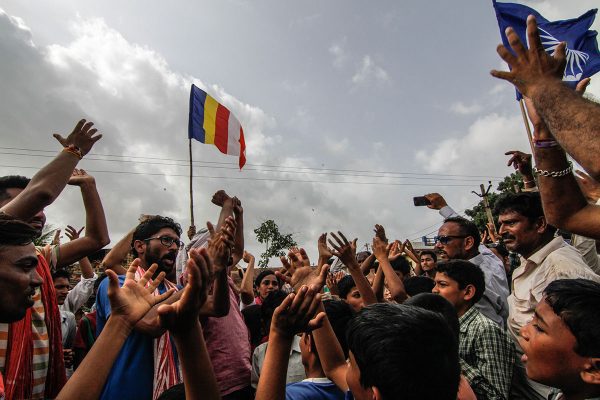The gendered responses to Deepika Padukone's video and the hierarchically prescriptive discources it generated reflect the hegemonic constructions of language, says Yogitha Shetty.
I watched My Choice a week after its release (chiefly for the voiceover). A subsequent discussion with a like-minded friend confirmed my opinion—it was in all senses a very elitist ad-cum-empowerment-video and universalist in glossing over all the particularities of women’s (unquantifiable) experiences the world over. The fact that this narrative could only cater to the needs and choices of a specific social strata was evident at first sight.
The caption read: “What happens when 99 women from varying walks of life come together to send out one powerful message?” I tried hard to locate that “one powerful message”: amidst disparate things ranging between soul to the universe, body to the forest, non-conjugal sex to conception-at-will, it seemed to make a case for ‘her’ ‘choice.’ It said it was meant to symbolise “women from varying walks of life,” and to justify the claim, had fleeting visuals of ‘tribal’, 70+ women. Interestingly, the images used to represent these yet-to-be-‘moved’ women are static and devoid of any animated movements, in contrast to that of the actress and her likes from the urban upper classes. Further, in a far-fetched metaphor, it had a fully-pregnant woman to speak on behalf of a “size 15, not size zero.” These moving/un-moving visuals speak about the non-verbal, inscribing language of the dominant camera, of the image-mover.
Many commentators have already criticised its ‘elitism,’ ‘hypocrisy’ and as expected, the internet has responded with ‘male My Choice videos.’ Like a writer points out, the criticisms are threaded around the troika of Deepika-Vogue-Sex—the fetishised actress, capital-consumerist Vogue and debaucher-woman paradigm.
In particular, creating the many male versions of My Choice has been a popular gendered response. Parodying the narrative of Vogue’s My Choice, superscripting it with a seemingly pregnant woman’s fight with her husband over marital disloyalty; talking about mom’s choice in his marriage; the choice to ‘love a woman or a goat’ as a response to Vogue’s formula of empowerment has been the focus of these videos. Although one cannot stop but notice the farce behind such male(d) versions, they also help us reflect on the inappropriateness of ‘choice’-oriented politics that efforts like Vogue-empowerment offer. The insufficiency of feminist politics on the grounds of ‘choice’ by overlooking the influence of regulating external forces on the constructions of gender and gender perceptions are conveniently glossed over in My Choice.
When most of our ‘choices’ are conditioned by our social, economic and political contexts, how can we propose a case for the ‘infinite’ woman? Living in one of the Tier-1 cities in the country, do I have the ‘choice’ to return home peacefully late at night without being sexually objectified by passerby’s gaze and gestures? Can the 4 am return only ‘upset’ and a 6 pm return only ‘fool’ you, and not evoke any other emotion within me? Do I have the choice of not being either size 0 or size 15 when I am anaemic or when my hormones blow out? Are classed ‘cotton’ and ‘silk’ the only signifiers of the disparities existing in Indian society? Are all the ‘seven billion’ available to me for choice in marriage, when the marriage broker’s preoccupation is my height, my weight, my wealth, my complexion and most important, my caste? Is my friend’s choice to be like many happy ‘normal’ women around incongruous in the normalising narrative of My Choice? Is asserting women’s rights restricted merely to declare their control over time, dress and sexual activity? And is ‘she’ untimely in questioning if this bohemian individualism will signify a rosy path to her at all?
The boomerang effects of an endeavour like this, especially for the cause of women’s struggle for empowerment is succinctly pointed out by Radhika Santhanam in a recent article for The Hindu. In its over(t)ly-emphasised libertarianism, she wrote, “what [the video] does instead is to misunderstand the term empowerment, speak of women’s choices within the personal domain rather than the public, and package feminism in a seductive manner causing more harm to the movement than good.” Social, political and economic factors exerting control over the fashioning and refashioning of womanhood and its conceptualisations in the public sphere are completely glossed over by the singular ‘voice’ in the video. The fleeting visuals of 99 women ‘from varying walks of life’ are ironically heard only through the lyrical, glamourised articulation of the ‘perfect-bodied’ Meryl Streep of Bollywood, Deepika Padukone. The very idea of unique women that the video claims to represent is overshadowed by the singular, eclipsing narrative of individual ‘choice.’
Moving away from the Vogue video, and shifting the focus away from my critique of it, a recent post on Facebook juxtaposing an audaciously-posed Deepika and a medal-clad Saina Nehwal with supposedly dichotomous options of empowerment caught my attention for different reasons. While I am clearly critical of the generalising tendency and extrapolating potential of My Choice, the sexist responses it has been evoking on social media is the face of a debilitating socio-political reality in the country. Ghettoising women into the discourses of home and nation (and, caste and religion, of course), more so by ‘taming the shrew’s sexuality’ to appropriate her into these two categories, is a popularly observable phenomena. It is all the more evident in the unrestrained and seemingly all-pervasive public sphere of social media. Offering the ‘choice’ of empowerment through the concurrent placing of two divergent personalities, the Facebook post ingeminates the deep-rooted patriarchal conceptions it has maintained for centuries in the subcontinent.
This is one of the countless posts pouring in and out of Facebook every day. But why did it spur me to pen this piece? Perhaps because it also included my own cousins and friends ‘liking’ and ‘sharing’ it, and more because I painfully see that they do not realise the hegemonic patriarchal and nationalist language they have subscribed to.
A common thread to connect these two unrelated ‘empowerments’ is difficult to locate in this post. One is an actress and the other a sportswoman by profession. The huge box-office success of Yeh Jawani Hai Deewani or Om Shanti Om doesn’t lend itself as a sufficient marker of success against Saina’s medals. On the other hand, neither do we get Saina’s position on sex-outside-marriage or her sexual orientation in comparison to that of Deepika’s. The ‘slut’ that the language of ‘emancipation’ makes out of Deepika stands in contrast to the non-verbal on-court performance of Saina. Although Bollywood has synecdochically become an identifier for the Indian cinema at large, the ‘bodily’ skills of Deepika cannot match with the nationalist contributions of Saina’s hand. The onus of creating ‘proud’ parent- and nation-hood is on the shoulders of the player and not in the ‘bitch-tongue’ of the actress. Making the parents and nation proud, thereby lending the female body as docile enough, especially by repressing sexualities, the finish line of ‘female empowerment’ could be crashed through. By way of the rhetorical question of ‘desirable’ empowerment, the manoeuvring language of patriarchy aims to certify Nehwal’s as laudable. Constructing the notions of ideal womanhood within the norms of family, chastity and monogamic sexuality has been a prerequisite in the imagination of nation for centuries. Through her ‘excessive’language of ‘infinity’ the sexualised actress remains outside the fold of home and nation, and through that the discourse of ‘empowerment.’
Finally, both Vogue’s case for women ‘empowerment’ and the kind of hierarchically prescriptive discourses it can elicit as a response are a reflection of the hegemonic constructions of language. While the ‘excessive’ idiom of Vogue normalises female experience and the notions of liberation, the dominant language of patriarchy, family, sexuality and nation evoke a particular kind of ideal womanhood. The multiple female experiences have always remained an outsider to the captivating tendencies of hegemonic language.














